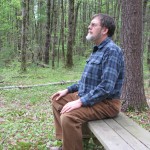
OK. This one’s going to be a bit notional. Here goes:
I’ve been challenged by A. Venefica of Symbolic Meanings and Mahud of Between Old and New Moons to participate in their mythology synchroblog on duality. You might think that would be an easy task, for a Pagan trained in two traditions of Wicca. After all, Wicca is known (sometimes a bit sneeringly) among other Pagans for its duotheism. The Mysteries of Wicca are expressed in terms of duality, and especially that of gender. Male/female. Goddess/God.
In Wicca, the world is also understood through relationship: a sexual relationship between the Goddess and the God, and a parental one with the world that is the product of their union. The world is not made, not created, but born out of that love.
Sometimes the point of spiritual training is to strive for the union or knowledge of both polarities–for the man to embrace his anima, and the woman to embrace her animus. Sometimes it is simply the celebration of the complementary nature of all aspects of the world in recognition of the complementarity of the God and the Goddess.
Unfortunately, there are a lot of reasonable objections to this approach to worship.
First, it’s biologically false to assert, as many do, that all life is gendered, male and female. This is nonsense. (Counter examples include hermaphrodism, sequential hermaphrodism, bacterial conjugation, and, of course, asexual reproduction. It just ain’t that simple, folks–even before we consider our own species.)
Secondly, it’s essentialist horse-crap to equate feminine with dark, receptive, nurturing, etc; reversing polarities on the Inner Planes, however nifty it sounds in theory, is just repackaging the essentialism in a new color scheme. It’s still crap, even when it’s crap in a mirror.
Thirdly, the “All gods are one God, and all goddesses are one Goddess” quote flies in the face of a great deal (though not all) of what we know about how ancient pagan peoples viewed their gods. In a sense, the duotheism of Wicca can be viewed as as strong a denial of polytheism as the monotheism of Christianity… and hence the dislike many Reconstructionist Pagans feel for Wicca, or at least for the ways all too many Wiccans assume that their philosophies and practices are universal in the Pagan movement.
Fourth, this is a heterosexist lens with which to view a universe, and it’s no coincidence that a number of respected early Wiccan teachers and a small number of less-respected recent teachers did espouse homophobic views. Since I won’t be returning to this point, let me just say it here: it’s the coming together in love that matters, ladies and gentlemen… not the plumbing possessed by the celebrants. However, it’s all too easy, if your paradigm for sacred union is a heterosexual one, to conclude that other forms of union are not sacred. Not nice.
With all that in mind, it might surprise you to learn that I still cherish one of the first pieces of Wiccan liturgy I ever learned, the wine blessing that the Church of the Sacred Earth adapted from words traditional to the Odyssean Tradition of Wicca:
HP:The Sun brings forth light!
HPs: The Moon holds it in darkness.
HP: As above–
HPs: So below.
HP: As the athame is to the lover–
HPs: –So the chalice is to the beloved.
Both: (blessing chalice with athame as they speak)…And together joined,
We are One in truth.
For there is no greater power in all the world
Than that of people
Joined in the bonds of love.
Interestingly, most of the online versions of this liturgy have, like ours, been adapted from the original, dropping (as we did) stereotyped references to gender. I suspect that most groups who have adopted this ritual found, as we did, that there is nothing wrong with a little duality in your religion…
…provided you don’t take it too literally.
The core concept, that we are attracted across differences, is sound. Where we go wrong is in defining the most basic representation of difference–duality–as the limit of difference.
In a traditional Wiccan circle, many of us were taught to sit boy/girl, boy/girl, in a strict alternation around the circle. Some groups found it difficult to have odd numbers of coveners, because it would disrupt the gender (and thus polarity) alternation that, it was thought, acted as a kind of spiritual battery, charging up the circle for its work.
And that concept is both wrong… and right.
My husband and I learned early on in our lives as working partners in a Wiccan circle, that it was better not to sit either side by side or directly across the circle from one another. If we did, the powerful attraction we felt for one another in those, the heady early days of of lives together, would eclipse the softer, more subtle attractions of relationship with other members of a group. It did, in fact, act as a short in an electrical system might–and as the boy/girl polarity enthusiasts would predict.
But we have never found that alternating gender is neccesary in a working group that has been together for any length of time. If the dualism of Wicca is about recreating the creative potential of polarity, the key insight turns out to be this: there are not two poles of spirit, but thousands–or more accurately, billions. It is difference, not opposition, that creates complements. And so, the fact that Ravenwing loves heavy metal music but Oakleaf loves Bach, that Shadowhaven loves red meat but Dawnchild is a vegan, that Rowan is expecting her third child but Pixiedust is childless, creates all the polarity any active circle could ever ask for.
The problem, in other words, isn’t with dualism, but with literalism–with being unable to see the fullness of what dualism is the simplest form to represent: diversity coming together to shape wholeness.
It is the coming together of an ecosystem, not of day/night, dry/wet, or male/female dualities, that really gives life its richness and fullness. Duality is merely a symbol, in other words, for many-ness, variation, and diversity. For life. The coming together of male and female, Goddess and God, or, indeed, of any one human (regardless of gender) with another is, liturgically speaking, symbolic only of how life shapes harmony from difference. The underlying truth which literalism can sometimes obscure is this: that all of creation is an ongoing act of love.
I can live with that.
And though I might not describe myself any longer as Wiccan, and though a monotheistic tinge may be changing me into something some of my Pagan sisters and brothers might not recognize as kin, still, there is a place in me for the old, duotheistically-rooted insights that shaped my spiritual journey. It is still true:
There is no greater power in all the world than that of people–of all of us beings, of all of us spirits, of all of the myriad individualities of all of nature and mankind alike–joined in the bonds of Love. The Spirit that joins us makes us whole.
Photo courtesy Caroline Tully’s Necropolis Now.
More duality (or non-duality) Synchroblogging Goodness available by May 1st (at least in theory) from:
Between Old and New Moons
Goddess in a Teapot
Jewish Myth, Magic and Mysticism
Full Circle
Mythprint
Stone Circle
Women and Spirituality
Frontiers of Wonder
Religion Think
Paleothea
Quaker Pagan
Heart of Flame
Pitch 313
Executive Pagan
Druid’s Apprentice
Druid Journal
Manzanita, Redwoods and Laurel
Dream Builders
When Isis Rises















